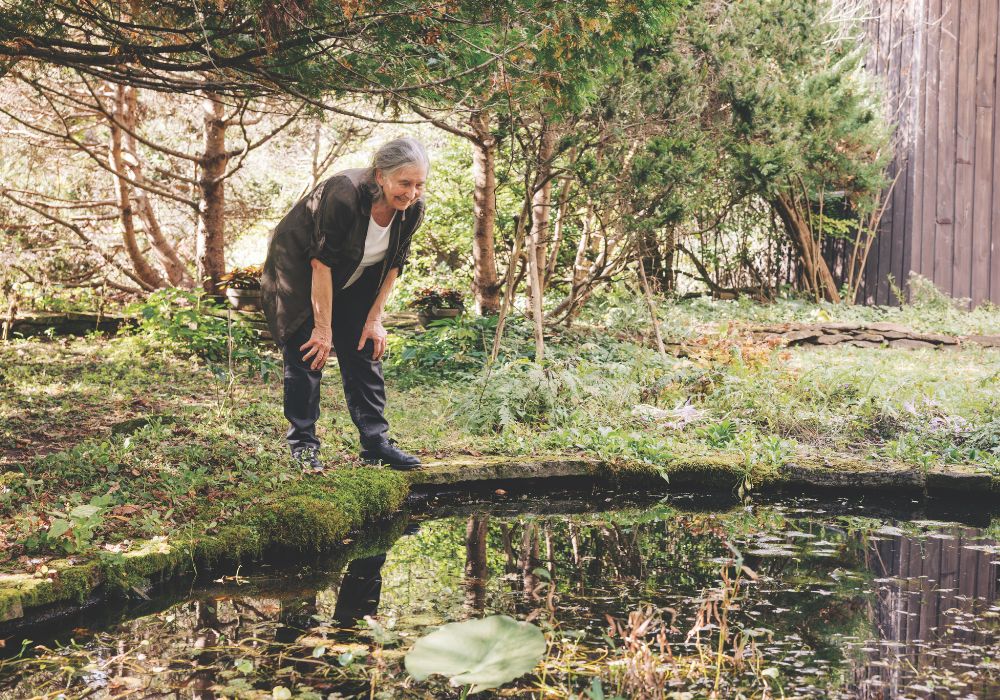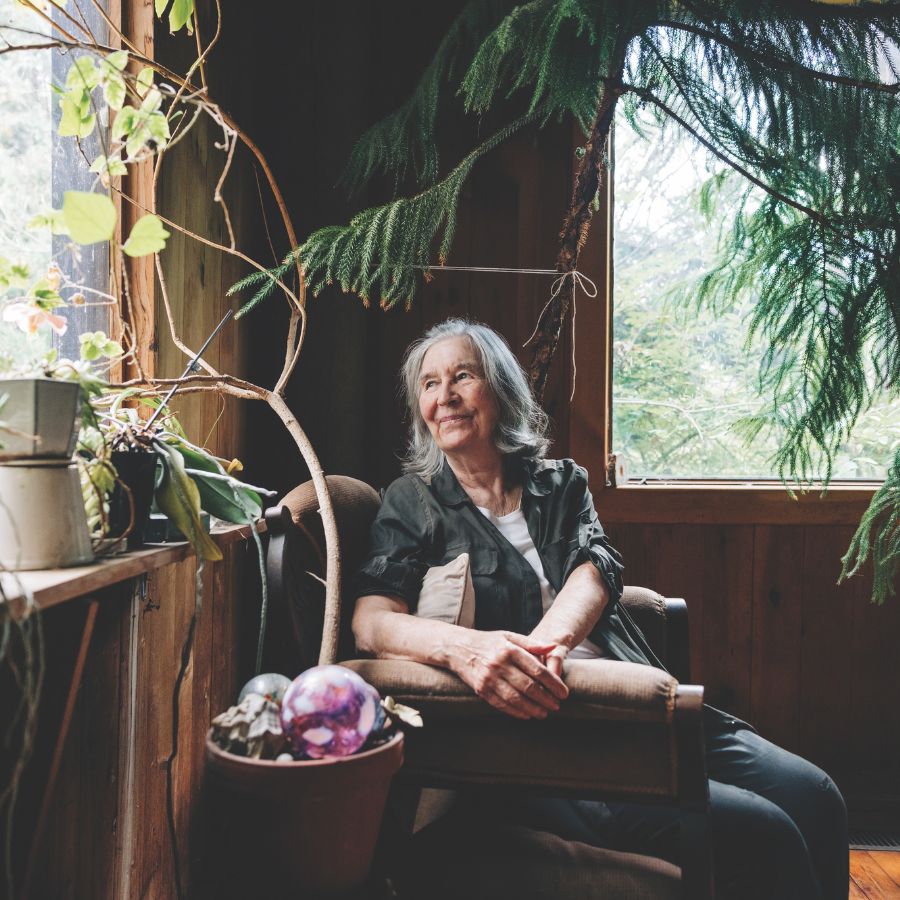It’s the middle of August and around the world, trees are burning. In Jasper National Park, nearly 320 square kilometres of forest have been left charred and smouldering. In Greece, 25-metre flames rip through the remaining pine forests of Attica not far from Athens. All the while in Brazil, 13 million acres of the Amazon have gone up in flames, fuelled by a historic drought.
And on 200 acres of woodlands and forest gardens an hour outside of Ottawa, Diana Beresford-Kroeger is trying to seed a revolution to save the global forests. “This is a living planet. We will not have a living planet without those trees,” says the 80-year-old Irish botanist and medical biochemist over tea in the home she and her husband built by hand half a century ago in Merrickville, Ontario.
Beresford-Kroeger has been called “the Jane Goodall of trees,” though she’s also an old-school renaissance woman: over the years, she’s conducted scientific research on organ transplants and open-heart surgery, cloned endangered trees for her forest genome project, and studied the plant aerosols that she says make forests a “living library of medicine.”
Having just published her eighth book, Our Green Heart: The Soul and Science of Forests, she’s made it her life’s work to educate the rest of us – from schoolchildren to world leaders – on how none of us would be here without trees. “They are the top and the bottom of the pyramid of life,” she writes, explaining how the molecules of decaying leaves reach the oceans to feed fish and whale calves and how the “fingers of the forest touch the atmosphere and dip into the human heart to keep it pumping.”
In early September, speaking at the Eden Mills Writers’ Festival an hour outside Toronto, she’s frank about what’s at stake in a world with fewer trees. “The oxygen that is in the atmosphere does not come from a mysterious place. It doesn’t come from fairyland. It comes from the bloody trees over your head right now,” she says to a chuckling audience.
The problem: “We’ve only been so stupid as to cut down the global forests . . . So it means there’s less oxygen in the air and more carbon dioxide. Today, we have [roughly] 420 parts per million of carbon dioxide in the atmosphere. The last time it was like that was millions of years ago. We’re heading to danger.”
Beresford-Kroeger was first warned about climate change in the ’60s by her uncle Pat. As an orphan growing up in Ireland, the self-described “aristocratic mongrel” immersed herself in her uncle’s library and spent summers on her great-aunt’s farm in the Lisheens valley.
“I inherited knowledge rather than money,” she laughs, explaining that she received an ancient Druidic education, instructed in Celtic knowledge of plants, nature and the sacred importance of trees. Later, she was told to go to the New World to become “as educated as she possibly could” and teach people about the value of nature to help humanity shed our destructive ways.

Roughly 10 million hectares of forest are cut down every year around the globe, according to the United Nations. Foresters would make the case that they’re replanting trees, sometimes at a two-to-one rate. The hitch: “We are planting the wrong trees in the wrong place.” It’s like, she says, hoping for a donkey to win the Kentucky Derby.
And, she explains, we’re paying the price with more destructive fires. Up the western seaboard, for thousands of years, giant redwoods acted as a great green firewall – until they began to come down and get replaced with non-native trees like eucalyptus in California and Scots pine in Canada.
“The species of North America are used to fires, but not to eucalyptus fires, not to Scots pine fires,” she says. “It’s an inferno.”
She knows from experience the impact of planting the wrong trees in the wrong place. A decade after Beresford-Kroeger moved up to Canada from the United States in the 1970s to work at the University of Ottawa as a research scientist, she and her husband bought a neighbouring plantation of Pinus banksiana – a non-native Jack pine from the Boreal north – hoping to put an end to chemical pesticide use on the property
The species of North America are used to fires, but not to eucalyptus fires, not to Scots pine fires. It’s an inferno.
“They’re not trees. They’re a fire hazard,” she says of the monoculture woods lining her kilometre-long driveway. Being the scientist she is, she also sees them as a bigger blackboard for her research on the climate crisis. For decades, she’s been tinkering in her research garden, planting what she calls a Noah’s ark of thousands of rare and endangered trees, like the native pawpaw, the cucumber tree (Canada’s only native magnolia) and the mighty kingnut (which she says would double the plant-based protein of any farming operation). The kingnut was wiped out in wartime for use as sailing masts, she says, pointing to the “little darling” she grew from seed on a tour of her forest gardens. She’s gathering seeds from the most climate-resilient of her trees. “I’ll find people to take them and to grow them.”
It all plays into the larger “bioplan” she has for us. Step one of the bioplan: stop cutting down ancient virgin forests. These mother trees are survivors – they are grandparents that hold in their DNA the knowledge of how to weather hundreds, even thousands, of years of climate hardship, as well as vital medicines still being discovered by scientists. But in British Columbia, for instance, ecologists say that just 3% to 20% of old-growth trees – more than 250 years old – are still standing, despite promises from the provincial government.
Step two: plant the right trees in the right place; one native tree per person per year over the next six years for a global total of 50 billion trees by 2030. “That will start reversing the CO2 in the atmosphere in parts per million down into the three hundreds.”
In recent years, politicians in Canada, the United States and other countries have promised to plant billions of trees to counter rising carbon in the atmosphere, but, Beresford-Kroeger says, they’re failing. “Climate change is too important [to be left to] politicians. It has to be in the hands of people.”
We must plant native trees, one per person per year for the next six years. That will start reversing the CO2 in the atmosphere.
Our Green Heart weighs in on solutions for industry, too. Beresford-Kroeger is optimistic about direct carbon capture – nascent technology pulling carbon from the air – to turn planet-warming gases into hydrocarbon fuels for cars, planes and tractors. “All of nature’s currency is carbon. So what you’re doing is you’re using some of nature’s carbon currency. As long as you’re not abusing it, it can be managed harmoniously.”
RELATED:
Tree planting in the face of wildfires
It’s time to start planting forests (not just trees) to grow Canada’s climate solutions
But she slams geoengineering – climate engineering that involves the likes of shooting fine dust into the upper stratosphere to reflect sunlight back to space – as arrogance of the highest order. Especially when the very service of shielding the earth against sunlight is easily provided by the clouds that form in part through moisture released from the globe’s forests. Although in places like the Amazon, so much forest has been cut down that rain clouds have been vanishing, drying up riverbeds and dragging out a historic drought that’s fuelling South America’s fires.
When I ask what she thinks of companies using tree-planting as a shell game to offset their polluting emissions, she says that if carbon-intensive industries are having a hard time curbing emissions, they should be tapping young minds at universities for the most innovative solutions.
Education is step three of her bioplan. She’s looking for ambassadors to help her spread her message. “I’ve written all of these books,” she says. “I can only do so much. I want to get the message out there to people: they’ve got to pay attention to nature. It tears me apart that I know that window of opportunity is closing and I won’t be around.”
As we finish our tea, I ask if she has hope for us. “Oh, yeah!” she says, lighting up. “What I have is hope in the young people. There are some extraordinary young people who are doing incredible things.”
And for the rest of us, there is still time to turn over a new leaf.
Adria Vasil is the managing editor of Corporate Knights and the author of the Ecoholic book series.






